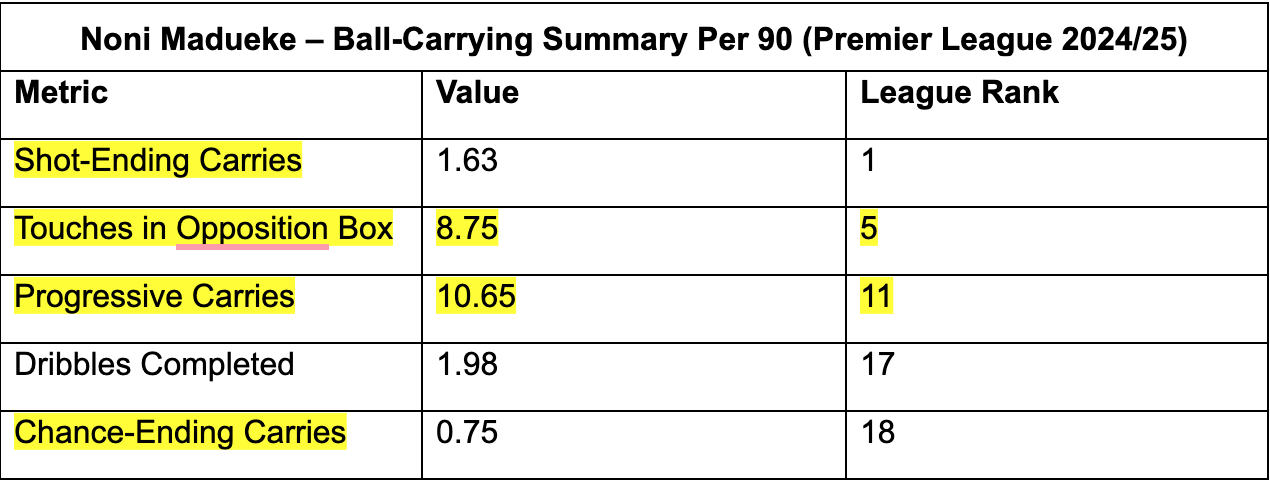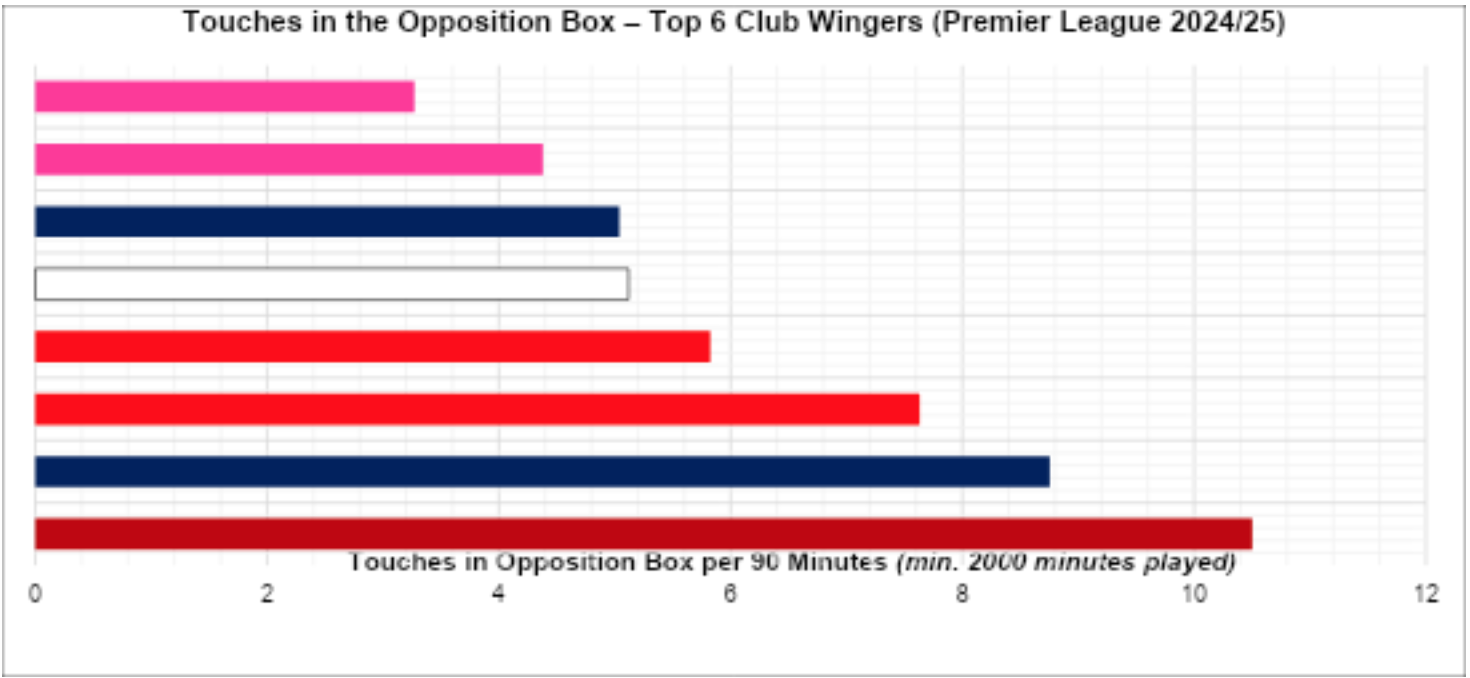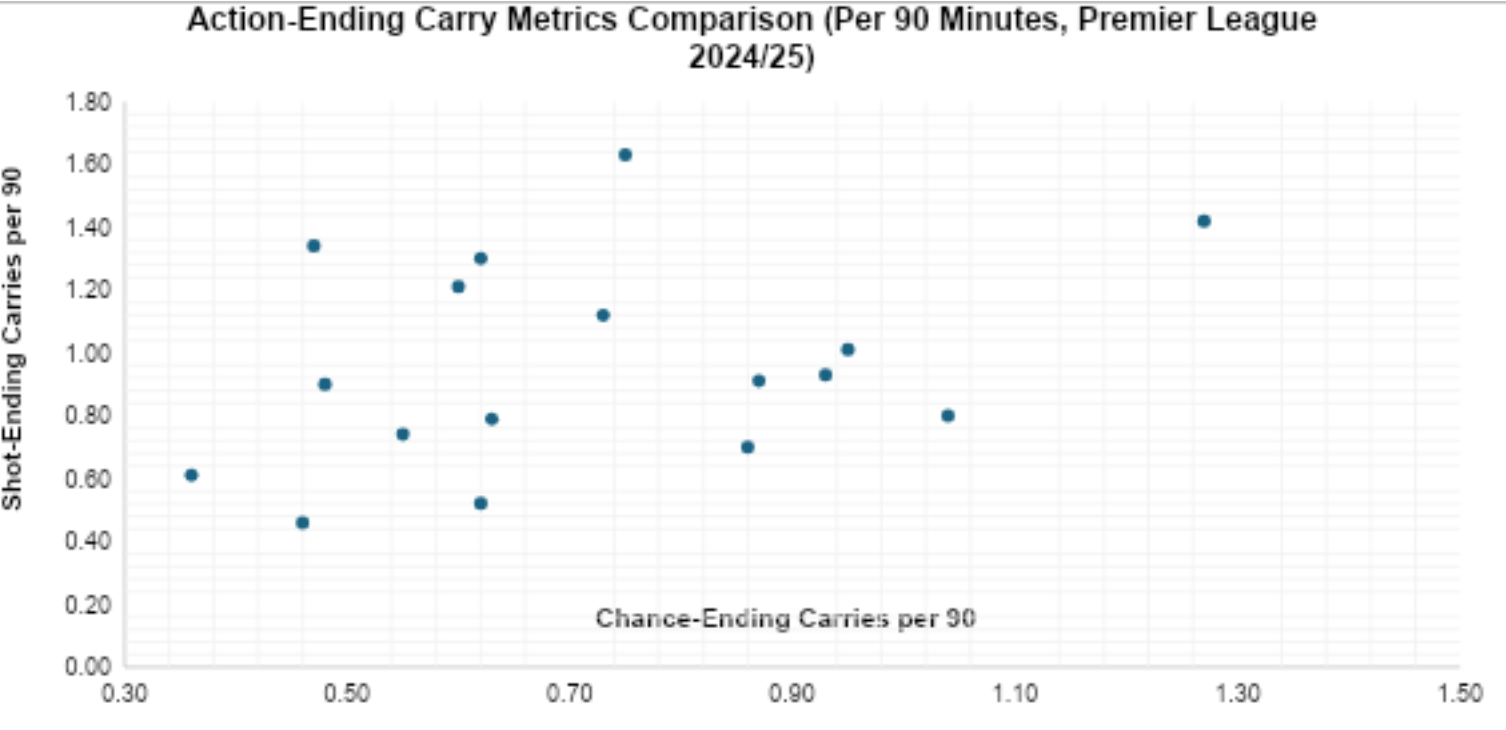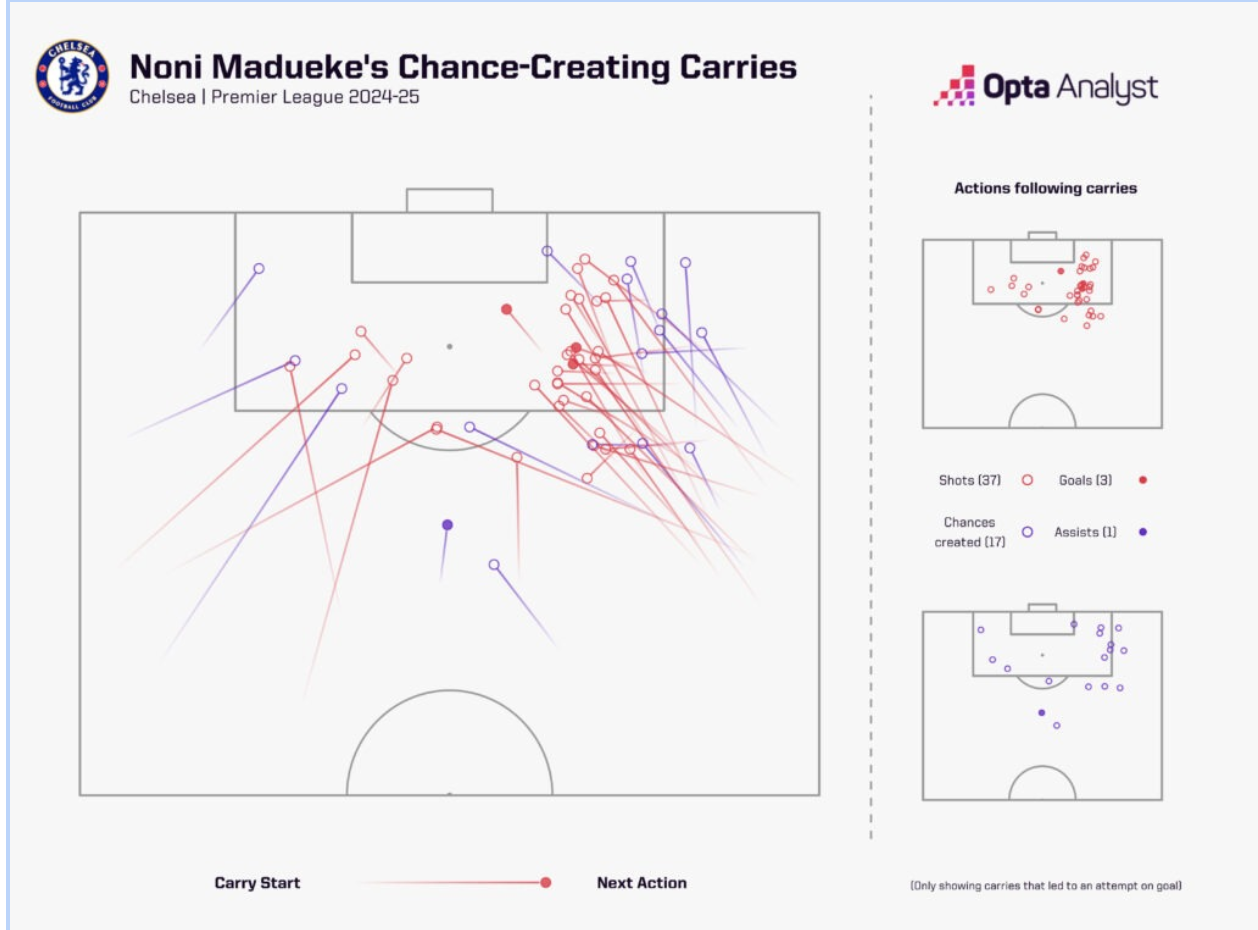Noni Madueke: An Analysis into One of the Premier League’s Elite Ball Carriers
With Bukayo Saka sidelined for three months last season — a setback that significantly blunted Arsenal’s attacking momentum — the need for reinforcements on the flanks has been evident for some time. Given earlier links to Leroy Sané and Bryan Mbeumo, it’s no surprise that the club ultimately targeted the profile of a left-footed winger capable of progressing the ball up the pitch through carries and individual duels, while also contributing in both chance creation and finishing.
The surprise came in the form of Chelsea’s Noni Madueke — a signing that sparked frustration in some sections of the fanbase. The winger becomes Arsenal’s fifth outfield acquisition from Chelsea under Mikel Arteta, continuing a transfer pipeline that has produced mixed results. Alongside Cody Gakpo, Marcos Senesi, and Lisandro Martinez, he is yet another player who polished his skills in the Eredivisie before taking his talents to England. And after struggling to convince in West London, he’ll be hoping to get his career on track in North London and push on for a World Cup spot.
Madueke’s underlying metrics, however, paint a far more compelling picture. His elite ball-carrying numbers, 1v1 ability, and directness in possession mean Arsenal have acquired one of the Premier League’s most dynamic progressors — and one who may not be arriving merely to deputise for Bukayo Saka, but to complement him. The numbers offer insight into why Mikel Arteta was, intriguingly, intent on bringing Madueke to the Emirates.
Physical Profile:
Standing at 6’0” with a lean frame and long limbs, Madueke isn’t your typical winger in terms of build. Physically, he’s more reminiscent of Leroy Sané — lanky but deceptively agile. A naturally left-footed attacker, his long legs enable him to cover ground effortlessly with lengthy strides, allowing him to glide past defenders and explode into space once he’s wrong-footed them.
While he’s by no means a physical meat tank in the mold of Adama Traoré, Madueke possesses a strong core and broad shoulders that give him excellent balance and upper-body strength. He’s particularly adept at using contact to his advantage — often riding challenges and bouncing off opponents, rather than being easily muscled out of possession.
Madueke only recently turned 23 — an age that sits in something of a grey area when it comes to a footballer’s development. Some players are already established stars by that point, while others are still ironing out the raw edges of their game. For context, Madueke is less than a year younger than Bukayo Saka, yet their career trajectories have differed significantly.
While Saka has long been an established fixture in both Arsenal’s starting XI and the England national team since the 2019-2020 season, Madueke was still plying his trade in the Eredivisie with PSV and only made his senior England debut this season.
Efficiency Over Flair: Dissecting Madueke’s Wing Play and Ball Carrying
“I only really have one thought in my mind when I get the ball to feet or in space — it’s just to line up the full-back and go past him. So that’s definitely one of my main strengths,”-Madueke. It’s a statement that reflects a player with a clear sense of identity — someone who knows exactly what he intends to bring to Arsenal’s flanks — and a statement that is backed by the numbers too.

In Noni Madueke, Arsenal have acquired a player who excels at carrying the ball from deep positions to progress play vertically. The data backs this up: among all Premier League attackers in the 2024/25 season, only Manchester City’s Jérémy Doku (21.77) — widely regarded as the archetypal 1v1 specialist — and Savinho (13.02) registered more progressive carries per 90 minutes than Madueke’s 10.65. These are defined as movements with the ball that advance play more than five metres upfield — a key indicator of ball progression.
What makes Madueke’s output even more compelling is the intent his carries. Of his 15.92 total carries per 90 minutes — defined by Opta as any movement where the player travels five metres or more with the ball — approximately 70% qualify as progressive. That ratio places him roughly on par with Doku and speaks volumes about his directness. Madueke doesn’t simply carry for the sake of possession, but instead consistently aims at advancing the ball vertically, getting his team into the final third.

That ball-carrying ability translates into a sustained presence in dangerous areas — particularly inside the penalty box. Among wingers from clubs that finished in the Premier League’s top six (minimum 2,000 minutes played), Madueke ranks second for touches in the opposition box, averaging 8.75 per 90 minutes — trailing only Mohamed Salah. It’s a metric that underscores just how frequently he gets into high-value attacking zones, whether through incisive dribbling or sharp off-the-ball movement.

What makes that figure even more impressive is the context in which this metric was achieved. At Chelsea, Madueke operated in a possession-dominant side frequently tasked with breaking down low blocks. That he was able to get into the opposition box regularly is a testament to the threat he poses — capable of making his way into dangerous positions through sharp off-the-ball runs or by carrying the ball directly past defenders to break through compact structures. It’s that blend of mobility, directness, and positional intelligence that makes his ball progression so impactful.
It’s this same directness that convinced both Enzo Maresca — and now Mikel Arteta — to view Madueke as the team’s outlet for progressing the ball into dangerous attacking zones. Its further enforced by the fact that Madueke led the entire Premier League in shot-ending carries per 90 minutes, with a league-best 1.63 — clear evidence that his dribbling comes not just with progression, but with the intent to hurt the opposition.
However, Madueke’s end product evidently leans more toward finishing than facilitating.

His chance-ending carries drop to just 0.75 per 90 minutes — ranking 18th in the Premier League — which aligns more closely with the profile of a goal-hungry winger in the mould of Mohamed Salah. There’s a noticeable streak of selfishness in his game — not inherently a flaw, but rather a reflection of a player keen to take it upon himself to make decisive contributions in the final third.
Madueke’s ball-carrying tendencies are well illustrated in the Opta Analyst graphic below. What immediately stands out is the volume of his drives into the penalty area, reinforcing the earlier point about his high number of touches inside the box.
A significant cluster of his ball-carrying actions see him sharply cut inside onto his favoured left foot, often from the byline or right half-space depending on the full-back’s positioning. This diagonal movement typically results in him entering the box and getting a shot off. Once inside, Madueke effectively seizes control of the phase of play — where a single mistimed challenge from a defender can easily result in a penalty.

Although not nearly as frequent as his trademark cut-inside move, the graphic indicates that Madueke is more than capable of going outside his full-back — driving to the byline and delivering crosses with his right foot. Whether it’s a clipped ball to the far post, a cut-back to the edge of the area, or a drilled cross through the so-called “corridor of uncertainty” for late-arriving runners or a central striker, it adds another layer to his game.
By: Hasan Ahmed
Featured Image: @GabFoligno / BSR Agency – Getty Images
